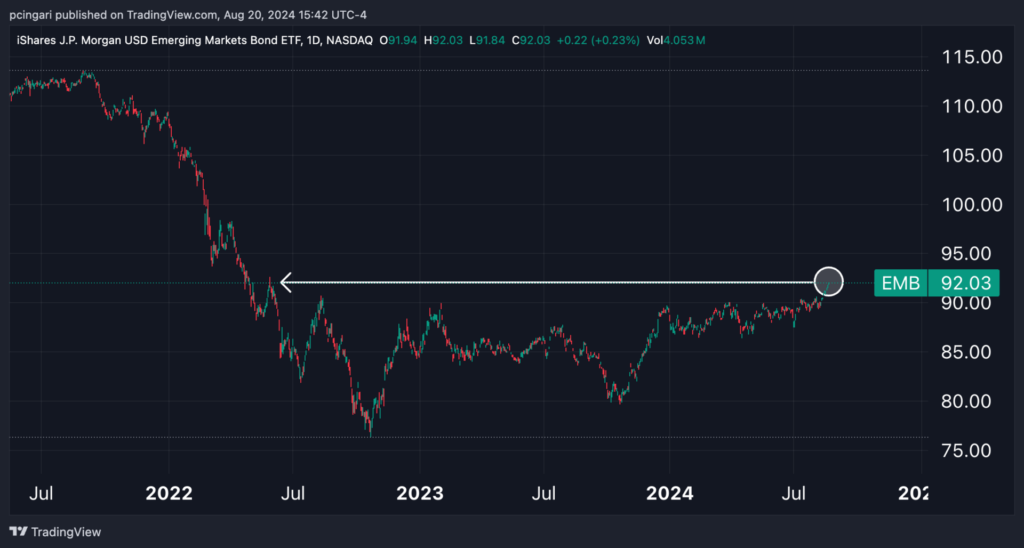Zinger Key Points
- Emerging market bonds surge as traders anticipate Federal Reserve rate cuts, lifting bond ETFs to multi-year highs.
- The iShares J.P. Morgan USD Emerging Markets Bond ETF (EMB) sees nine gains in ten sessions, reaching May 2022 levels.
- Feel unsure about the market’s next move? Copy trade alerts from Matt Maley—a Wall Street veteran who consistently finds profits in volatile markets. Claim your 7-day free trial now.
The bond market of emerging economies has experienced a strong upswing in recent sessions, driven by rising expectations that the Federal Reserve is nearing a policy shift toward cutting interest rates.
The iShares J.P. Morgan USD Emerging Markets Bond ETF EMB, which tracks dollar-denominated bonds from around 30 emerging-market governments, has rallied to levels last seen in May 2022, recording gains in nine of the last ten sessions.
Similarly, the iShares J.P. Morgan EM Local Currency Bond ETF LEMB, which invests in local-currency-denominated bonds from emerging markets, has climbed to a one-year high.

EM Bonds Rally As Traders Eye Lower U.S. Interest Rates: Dollar Weakens
Much of this outperformance in the local currency sovereign bond market has been concentrated in Latin America and in countries like Mexico, Brazil, and Poland, which have struggled for much of this year, according to Tadas Gedminas, an analyst at Goldman Sachs.
Gedminas also highlighted that “diminishing U.S. growth exceptionalism and greater confidence in the start of the Fed’s easing cycle should ease constraints on emerging market policymakers and support a broader cycle of rate cuts across these economies.”
Goldman Sachs anticipates that central banks in South Korea, South Africa, and India will begin easing policy rates before the year ends.
Traders are fully pricing in a U.S. rate cut in September, with market-implied probabilities suggesting a 73% chance of a 25-basis-point cut, with additional reductions expected in November and December.
On the currency front, the U.S. dollar has weakened in August, particularly against Asian currencies.
The greenback has fallen by 5% month-to-date against the Indonesian rupiah, marking the rupiah’s best-performing month since April 2020.
The dollar has also depreciated by between 3% and 4% against the Malaysian ringgit, Thai baht, Philippine peso, and Korean won.
In Latin America, the dollar has dropped by over 3% this month against the Brazilian real, on track to end a streak of seven consecutive months of strengthening.
Improving Capital Inflows Into EM Economies
An International Monetary Fund (IMF) report released last week highlighted a slight recovery in net capital inflows to emerging markets and developing economies from the lows experienced in 2022, although they remained negative overall in 2023.
Excluding China, which continued to account for a large share of negative net capital inflows, other emerging markets as a group saw positive and increasing inflows.
High-frequency data from the IMF indicate that gross portfolio inflows into emerging markets, excluding China, were positive in the first few months of 2024.
These inflows were influenced by “fluctuations in U.S. financial conditions, with optimism in financial markets and the limited depreciation of the U.S. dollar in the fourth quarter of 2023 helping to rekindle capital inflows to emerging markets,” the Fund wrote.
Now Read:
Image: Shutterstock
Edge Rankings
Price Trend
© 2025 Benzinga.com. Benzinga does not provide investment advice. All rights reserved.
Trade confidently with insights and alerts from analyst ratings, free reports and breaking news that affects the stocks you care about.